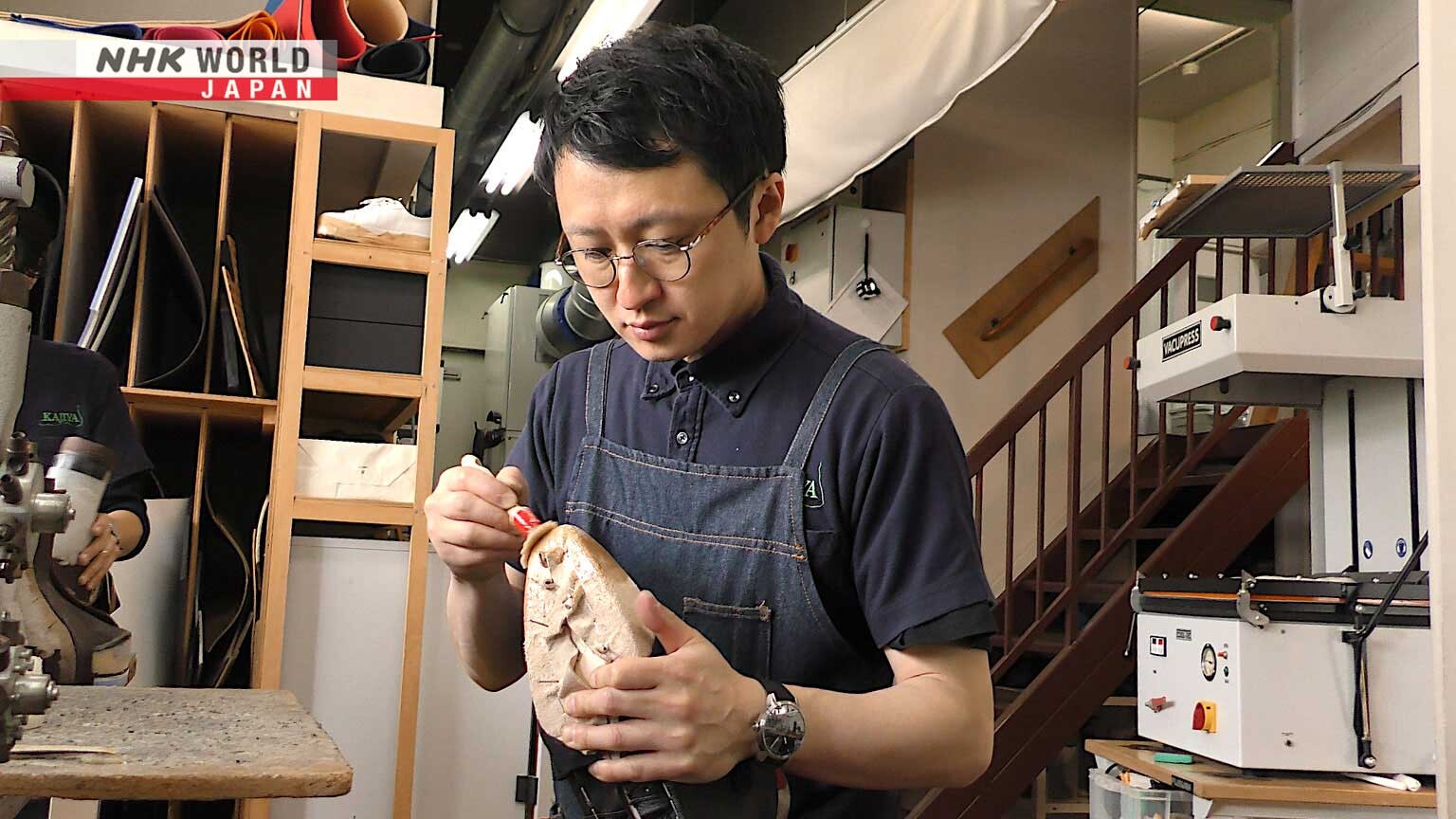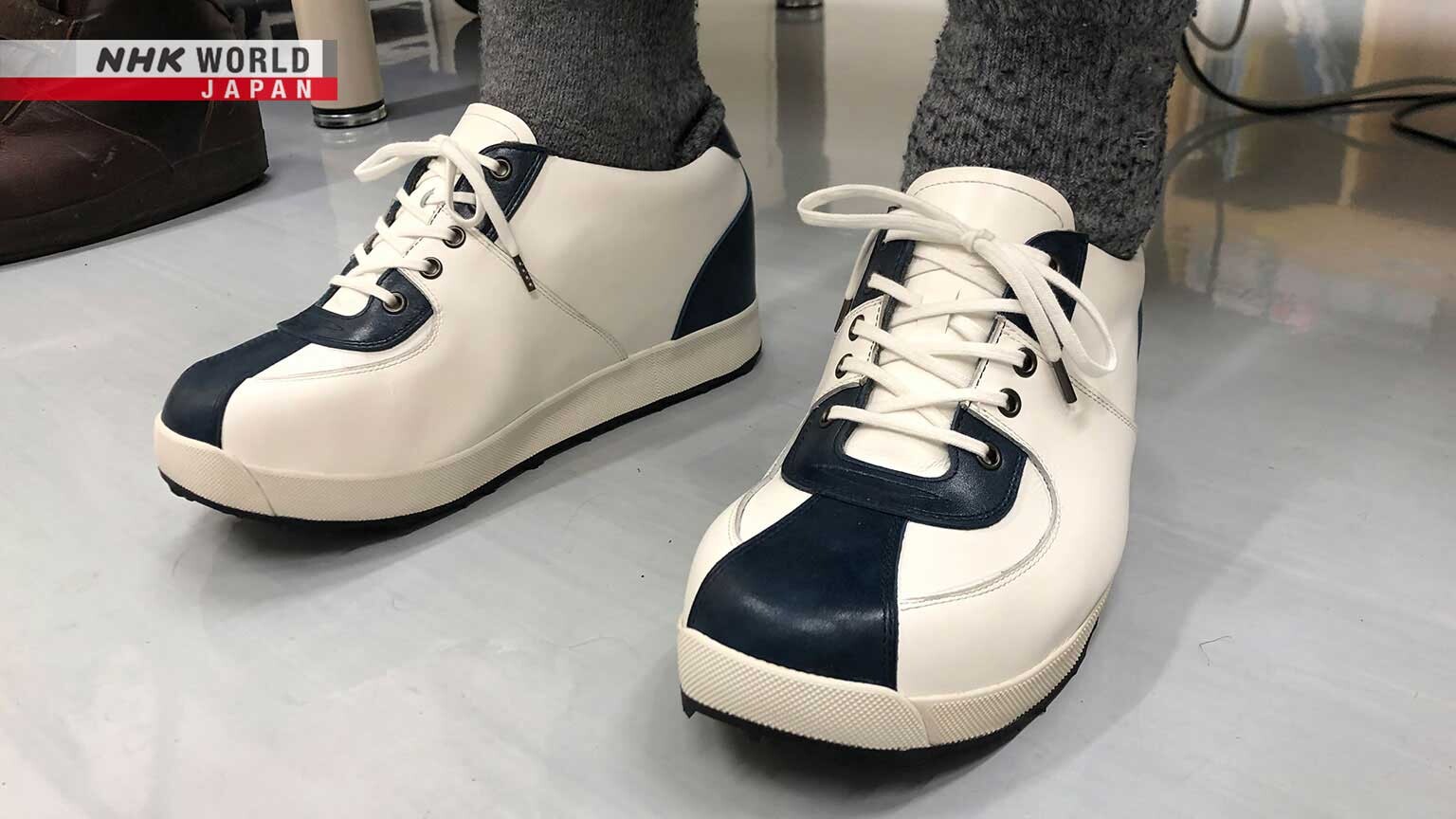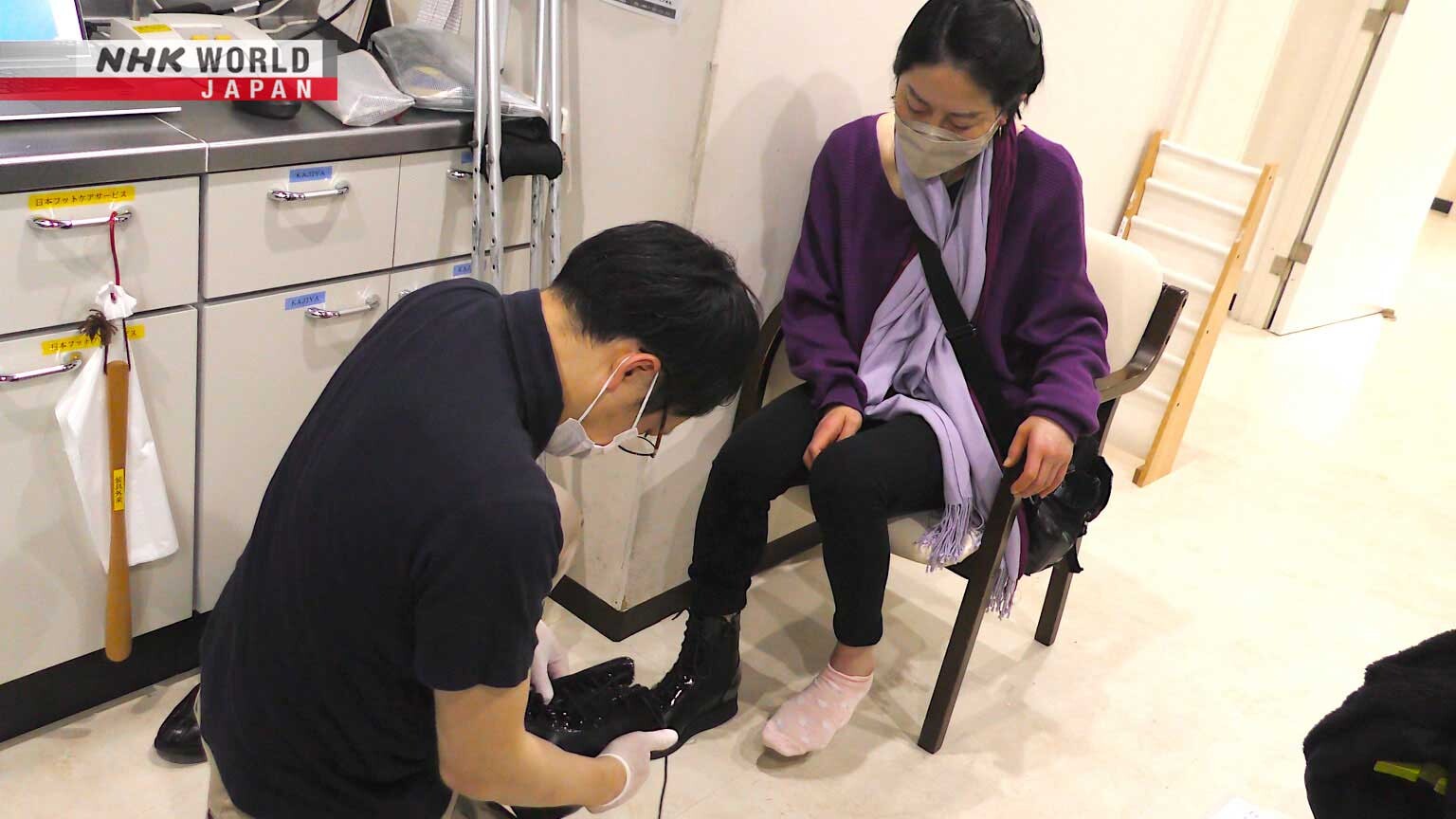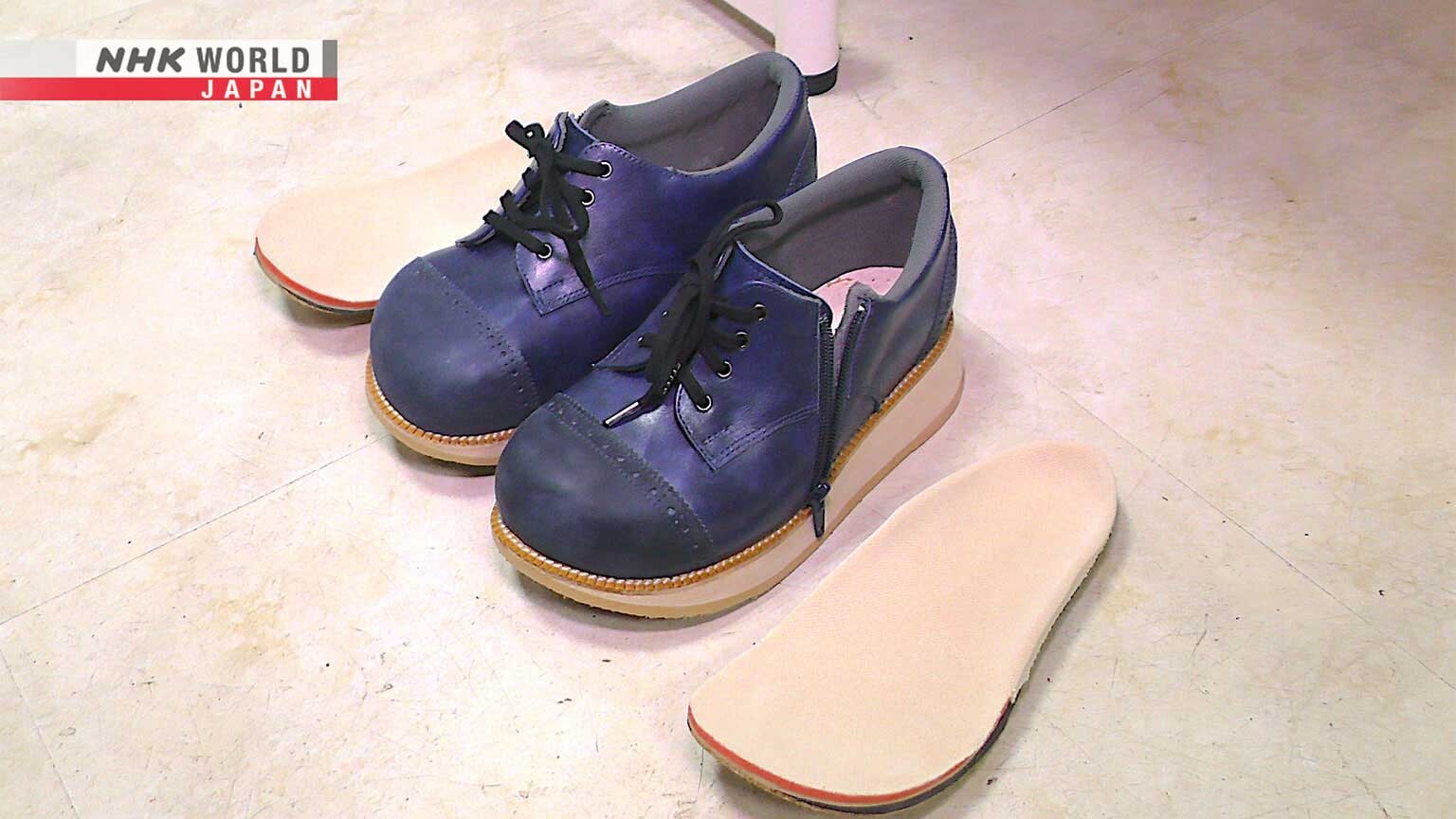Orthopedic Shoe Meister - Nakai Yosuke
Meet Nakai Yosuke, a qualified prosthetist and German-certified orthopedic shoe "meister" leveraging his skills to help Japanese seniors maintain their mobility and independence well into old age.




Transcript
FRONTRUNNERS
I want my shoes to be functional tools.
I lost two toes to diabetes. But I hope to regain my walking speed.
I can walk! I'm so happy!
I want to convey that walking is life. And help to promote lifelong mobility.
Orthopedic Shoe Meister
Nakai Yosuke
Higashi Kurume, around an hour's drive from central Tokyo.
It's the home of a unique shoe workshop run by Nakai Yosuke.
It's an old mold.
He specializes in orthopedic shoes
for wearers whose feet have been affected by illness or injury.
He holds the rare distinction of being both a qualified prosthetist here in Japan,
and a certified orthopedic shoe "meister,"
Germany's highest recognition in the field.
Recent years have seen a surge in a particular type of patient.
Shoes for diabetics need pretty thick insoles.
And enough room to fit them in.
We reinforce the front of the shoe
to reduce pressure on the foot.
Around the world, diabetes is on the rise,
with a threefold increase in sufferers in the last 20 years alone.
And the high blood sugar caused by the condition
can result in serious damage to various parts of the body.
High blood sugar impacts your circulation.
And the resulting nerve damage reduces sensitivity in the feet.
You end up not noticing any pain in your feet.
Small wounds can get infected.
And bad blood circulation will undermine your body's ability to fight off that infection.
Sometimes the infection gets really bad.
In the worst cases, amputation is required.
Nakai's work sees him collaborate with various hospitals and clinics.
Like this one, specializing in diabetes and podiatry,
where he hosts special consultations six times a month.
Today's patients include diabetes sufferer Sugawara Toshifumi.
- How's your wound been?
- It's getting much better.
It is! Took a while, huh?
A year ago, Sugawara's diabetes saw a small cut on his foot
deteriorate so badly that he had to have surgery.
Foot circulation issues are a hallmark of diabetes,
promoting sores that can become ulcers and even turn to gangrene.
Since his operation, Sugawara has been virtually unable to walk
while he waits for his wounds to heal.
I haven't walked for a year, so I've lost a lot of muscle.
Walking can cause sores, but if you don't walk, you lose muscle.
Next, Sugawara sees an in-house diabetes specialist.
- This toe-tip could be a problem.
- A callous? I hadn't realized.
If it deteriorates, this small callous on the second toe of Sugawara's right foot
may demand an amputation.
And in fact, ten years ago,
he already lost two toes on his left foot in exactly this way.
Back at his workshop, Nakai gets to work on shoes and insoles for Sugawara.
But with footwear for diabetes patients,
it is imperative not to impinge on the foot even slightly.
The insoles are a vital element.
Regular insoles might be three or four millimeters thick.
These are 15.
There's all sorts of cushioning built in, even in places where you can't see it -
multiple layers to absorb any impact.
In Japan, an official qualification in prosthetics
is a requisite for aspiring orthopedic shoemakers.
But few registered prosthetists are able to make footwear like Nakai's.
My aim is to provide shoes and insoles that let people walk day-to-day.
And help them to live out their days free from foot sores.
Funabashi is just east of Tokyo.
Sugawara Toshifumi lives alone in Funabashi.
In order to keep his blood sugar in check, he has to observe a strict calorie-controlled diet.
I think "soba" is about
80 kilocalories per 20 grams.
It was 20 years ago, as a hard-working salesman for a printing company
that Sugawara was first diagnosed with type 2 diabetes.
Diet was identified as a major factor.
Back then, even for lunch,
I would usually go for the largest portions.
Nowadays he needs oral medication and insulin shots to keep his blood sugar in check.
Yet no matter how careful he is, his delicate feet are a constant worry.
I got carried away with my old insoles, did too much walking
and ended up with a callous.
He's desperate for a pair of shoes
that will allow him to walk freely without the risk of injury.
I love walking, and I love getting out and about.
I can be out for a walk, and people keep overtaking me.
No matter how hard I try,
I just can't keep up, and that's tough to take.
To bring down his blood sugar,
Sugawara's doctor recommended walking five thousand paces each day,
and he hopes that eventually he will once again walk like he used to.
With his new shoes and insoles ready at last, Sugawara arrives for a trial fitting.
But because the condition also results in nerve damage,
many diabetics struggle to properly assess the comfort and fit of shoes for themselves.
We've fitted pressure sensors, to see how the soles absorb impact.
Nakai uses precision sensors to measure the load on the sole of the foot.
Looks about perfect.
Not sure about this second toe, though. Let's tweak that a little.
There seems to be slight impingement on the toe
where Sugawara already has an early-stage callous.
So Nakai fine-tunes the insole in that area.
And with pressure now dispersed evenly all across both feet,
Sugawara hopes these new shoes will let him return to walking longer distances
while avoiding any further injury.
I plan to build my muscles back up through walking.
I still don't feel back to my old self,
but I'm determined to regain my mobility.
That's what I think as I walk.
And Sugawara is far from the only diabetes patient who's benefited from Nakai's care.
Apart from break times, I'm constantly on my feet.
Takashima Chiemi works in a care facility.
Another victim of type 2 diabetes,
since her right leg was amputated six years ago she has had to use a prosthetic.
And with only one toe remaining on her left foot,
Nakai has created a full-length boot to support her below the knee.
In this job you need to move around a lot.
And despite my concerns I just had to get on with it.
This boot gives me peace of mind.
Walking feels almost like it did when my foot was intact.
Five or six years ago when I had all my own toes.
I really wish I'd found Nakai-san sooner.
Nakai has made countless bespoke models for his many individuals with diabetes.
For one patient who thought conventional orthopedic shoes didn't look stylish,
he recreated the look of a favorite pair of boots.
For a keen golfer, he crafted a pair of orthopedic golf shoes
that allowed them to play again without exerting pressure on delicate areas of the foot.
There really are no limits to Nakai's ingenuity.
And this has helped him win the utmost trust of collaborators like Hisamichi Katsuya,
who is in charge of the diabetes clinic with which he partners.
When it comes to a holistic care program
that goes beyond the possibilities of just medication and surgery,
we see orthopedic shoes as an extremely vital component.
Even with seemingly impossible orders, Nakai-san will always come up with something,
so a lot of the time we just leave him to it.
And at such times,
we know he will use his vast experience to come up with solid ideas
that you won't find in any textbook.
Omiya is just north of Tokyo.
Nakai is here at a podiatry conference to share case studies on diabetes-related foot conditions.
I just hope I can finish within the allotted time.
Can't let my presentation run over.
And with diabetes care steadily broadening its horizons,
Nakai's orthopedic shoes are attracting a lot of attention.
The audience is full of medical professionals, including doctors, nurses and physiotherapists.
We talk about footwear for diabetics, but that encompasses various items,
including both shoes and insoles.
Nakai takes listeners through the respective merits of different types of footwear
for users with symptoms of differing severities.
After a partial foot amputation, we must compensate for the lost area.
The part I'm indicating in red supports the lower leg, but fits discreetly into the boot
so it looks just like a regular high top.
Nakai-sensei!
- What a great presentation!
- Thank you.
After the presentation, Agarie Yukio, chair of a major professional body,
as well as Nakai's former tutor, seeks out his ex protégé to extend his compliments.
I just hope people found it useful.
Japan's prosthetists lag on shoes.
I hope you can lead the way for our orthopedic shoe sector.
I remember that even as a student,
he used to say that he wanted to become a shoe meister.
That was his dream.
From a young age, Nakai Yosuke took an interest in both medicine and craftsmanship.
And after high school, he enrolled at a technical college to learn prosthetics.
Then, during his studies, he found a childhood photo of himself
wearing some interesting footwear.
See those three straps?
After asking his parents, he learned that from the ages of one to three,
he too had worn orthopedic shoes to correct inwardly turned club feet.
And this discovery would prove to be a turning point in Nakai's life and career.
I don't know if I could look back now and say it was a calling,
but I do find it rather intriguing to think that I also benefited from orthopedic footwear.
In that sense, I did start to think how my childhood experience
might have been the start of a theme that has set the whole path for my own career and occupation,
my whole day to day life as a technician, not just now, but in the future too.
It does sort of seem that way.
But despite setting his sights on becoming an orthopedic shoemaker,
options for learning this trade in Japan are almost non-existent.
With this in mind, after qualifying as a prosthetist, he travelled to Germany
and spent nine years striving towards the country's top tier qualification
as an orthopedic shoe technician, the title of "meister."
Now, 11 years after returning to Japan, he runs this workshop with a team of 20 craftspeople
I'm very conscious that if we don't keep on promoting these skills,
there are so many people in need that we'll never reach.
I want to bring happiness to as many people as possible.
And as Nakai's reputation has grown,
so has the number of people turning to him for help with their own mobility.
Sasai Tomomi suffered a serious injury to her spinal cord in a motorcycle accident.
Resulting in partial paralysis to her lower torso that curbs her ability to walk freely.
Your tight Achilles forces toe-walking with the outside of your foot turned down.
Causing pressure behind your little toe.
Our shoes will aim to correct that.
And here is the finished prototype.
Let's try standing.
To try and correct the alignment of Sasai's foot,
he has included a resin support that wraps around the Achilles tendon.
I can walk! It feels totally different.
Much less strain on my ankle.
I'm so happy! That's all I can say!
I'm going to walk straight to the pub!
- Ah, so you're a drinker!
- Yep. Love it.
- I want your bar tips for Shimokita.
- Let's go together sometime!
Thank you. Bye.
- Come in.
- Hello.
Next up is Miura Rumi, who heard about Nakai
after years of searching for the right shoes to no avail.
Having lost several toes due to severe burns sustained in an accident as a baby,
she's long suffered associated pain and discomfort.
I've been in constant pain.
Nakai's solution is these custom shoes
with uppers designed in a textile and color of Muira's specification.
To reduce pain as you push off, I've reinforced the toe spring.
Increasing the surface area of the toe spring at the front of the foot reduces pressure on the toe area.
- How do the toes feel?
- Totally fine.
I think we're good.
And they look good, so you'd never guess I have a disability.
They're cute.
Thank you very much.
Each year, Nakai delivers some 200 pairs of therapeutic shoes and even more insoles.
In terms of the look and design,
working closely with the end user like that makes things interesting for me too.
I think it's so important to help people who've lost the ability to walk, to get back on their feet.
And it's fantastic to be able to make things for people.
Another day, and another client visits Nakai's workshop.
This time, it's 18 year old Ito Ayane.
At the age of ten, she was diagnosed with a malignant tumor in her left thigh bone.
But the surgery to remove the tumor left her with near-total paralysis from toe to ankle.
This is from her first visit. Her big toe hurts, so she leans on her little toe.
As a result, walking has long been a struggle for Ito.
See how she drops her shoulder?
My body is out of balance, so I use a lot of energy.
And that is very tiring.
Nakai has prepared a prototype shoe using thermoplastic resin.
A particular challenge was the insole.
As well as raising the left heel to align with the shape of Ito's damaged foot,
he has thickened the sole of the right shoe to match.
- So you're graduating soon?
- Yes, it's almost March.
With a job lined up after high school graduation next month,
she'll be able to walk without pain through long days of working and commuting.
OK, let's do it.
With the shoes fitted, first, they examine Ito's gait.
And though her posture seems to be much improved...
Looks like we've overcorrected the foot rotation from outward to inward.
I'll fine-tune it.
He produces a one-millimeter-thick rubber sheet and applies it to the sole of the left boot.
Let's try walking again.
Even a millimeter's imbalance between left and right can cause a discomfort for the wearer.
But Nakai is a master of judging these fine margins by eye.
It feels better than before.
I think these are the right specs for you at the present time.
After the fitting, Nakai further fine tunes the sole with minute precision.
Comfort with standing and walking can hinge on a tenth of a millimeter.
A month later, Ito's shoes are finally ready.
Good afternoon.
I've gone with a grown-up look.
I like the black. Cool!
Let's try walking.
She looks much steadier.
We'll be good once she's used to them.
- Any discomfort? How's the big toe?
- No pain right now.
Father, Toshimitsu, is amazed by the improvement in his daughter's gait.
I see her every day, so I can notice the changes immediately.
She really does seem to be walking much more easily.
Three weeks later,
and Ito has already started her new office job.
The extra comfort of these boots
means I can walk more quickly, so it's great to get home faster.
And because I knew my posture was uneven,
I used to get down, comparing myself to other people.
But correcting that has given me more self-confidence.
It's like a symbol of how far I've come.
Satisfaction among Nakai's patients is so high that almost 100 percent keep coming back.
Recently, to help transform the lives of as many people as possible,
Nakai is also working to promote his approach through classes at a technical college.
Trim that down a little more.
This is a contact point with the ground, so let's grind it down a little.
You're young enough to be my son.
So what is it that motivates Nakai Yosuke as a frontrunner in the field of orthopedic shoes?
Walking makes you feel so alive. Lots of people experience that.
But it's a fact that across Japan there are still many people we haven't been able to reach.
My aim is to change that.